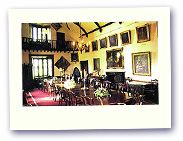 |
Search the site:

Malahide Castle County House, County DublinSuch was the troubled state of Ireland's past that few Irish country houses were ever continuously inhabited by the same family for more than a few centuries. A rare exception to this rule was Malahide Castle - home of the Talbots for 791 years. Granted in 1185 to Richard Talbot, one of the knights who arrived in Ireland with Henry II in 1174, the property remained in Talbot hands until 1976 when it was acquired by Dublin County Council. Unfortunately, the Irish government was unwilling to accept the property in lieu of death duties, and its remarkable collection of portraits and furniture, which uniquely reflected Ire land's historical and cultural development, had to be sold by auction. Fortunately, Ireland's tourist board, Bord Failte, managed to purchase much of the furniture at the sale together with the castle's carpets and curtains, and these remain at Malahide alongside thirty-five portraits bought by the National Gallery of Ireland. Further important acquisitions of Irish furniture have been added to the collection so that Malahide's interior still retains much of its old beauty and magic.
The core of the medieval castle is the oak room, approached by a winding stone staircase and lit by Gothic windows added in 1820 when the room was enlarged and the front hall below was created. The room contains fine carved panelling, mostly of sixteenth-century date, which has darkened to a gleaming ebony. Some of the carving is of Flemish origin, including six exquisite panels representing biblical scenes opposite the window; their religious theme suggests that the Talbots, who remained Roman Catholics until 1774, used this room as a chapel in penal times. According to tradition, Fortunately for the Talbots, the unsavoury Corbet was one of the regicides who signed the death warrant of Charles I and after the Restoration he was duly hung, drawn and quartered at Tyburn. Samuel Pepys recorded the occasion in his diary on 19 April 1662: 'This morning before we sat, I went to Aldgate and at the corner shop, a draper's, I stood and did see Barkestead, Okey and Corbet drawn towards the gallows.' The Talbots returned to Malahide and the figure of the virgin made a miraculous reappearance above the fireplace. Until 1976 the room contained James Boswell's ebony cabinet in which were found over 1,000 manuscript pages of Boswell's Life of Johnson in the 1920s. The thick walls of the oak room are flanked on the east side by the great hall, added to the castle around 1475. Unique in Ireland, this great hall not only retained its original form but also remained in domestic use as a dining-room until 1976. Its vaulted undercroft and corbel heads of Edward IV are original, but during the nineteenth century it was given a new roof, mantels and a minstrels' gallery. The furniture and pictures are of mostly seventeenth- and eighteenth-century date. The magnificent thirty-five-foot table comes from Powerscourt but many other items are original, including the nucleus of the Talbot ancestral portraits acquired by the National Gallery - a collection that is unusual since most of the Talbots' ancestors were Jacobites rather than the supporters of King William who usually decorate Irish country houses. Some valuable pictures were lost to this room in 1976, but the National Gallery managed to acquire a very fine John Michael Wright of Lady Catherine and Lady Charlotte Talbot. To replace lost pictures along the side wall, the National Gallery loaned the huge 'Battle of the Boyne' by Wyck - a superb picture that not only suits this room visually but is historically appropriate; on the morning of the Battle of the Boyne fourteen Talbot cousins, all followers of James II, gathered here to dine- none survived the carnage of the day. > > > Read the concluding part of this article From the Appletree Press title: Irish Country Houses.
|
All Material © 1999-2005 Irelandseye.com and contributors

 the Flemish carving of the coronation of the virgin over the mantelpiece disappeared when the castle was occupied by the Cromwellian Miles Corbet between 1653 and 1660.
the Flemish carving of the coronation of the virgin over the mantelpiece disappeared when the castle was occupied by the Cromwellian Miles Corbet between 1653 and 1660.